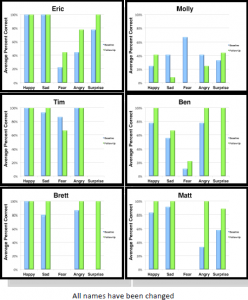Lucy Brimhall and Dr. Martin Fujiki, Department of Communication Disorders
Specific language impairment is traditionally defined as a diagnosis referring to “children who have difficulty learning language in the absence of intellectual disability, sensory and physical deficits, severe emotional disturbances, environmental factors, and brain damage” (Kamhi, AG 1998). Recent study of the behavior of children with SLI has revealed that there is a discrepancy between the social communication skills of typically developing children and those with SLI (Brinton & Fujiki, 2004).
Despite the importance of social communication, most interventions for children with SLI focus on improving structural language skills (e.g., teaching the child to produce syntactic structures). This project sought to investigate a social communication intervention protocol designed to simultaneously complement traditional language intervention and address deficiencies in social communication. For the ORCA grant opportunity, we chose to focus specifically on an aspect of the study that evaluated the social communication skill of emotion recognition.
Six children (ages 5-7) with language impairment were selected to participate in the study. All participants were enrolled at an elementary school in Orem, Utah. We used a single subject, multiple baseline design. During baseline we assessed the facial emotion recognition abilities of each child before they underwent treatment. We used Paul Ekman’s test for emotion recognition, which required the children to identify the facial expressions on various photographs representing happy, sad, fear, angry, and surprise. In cooperation with a team of two professors, one doctoral student, four MS students, and three undergraduates, a 20 session intervention program was designed. The MS students administered treatment over the course of several weeks, with the assistance of the undergraduate students. This intervention intended to help improve the emotional awareness of each child with LI and therefore improve their social communication, skills, and situation.
The children each completed Paul Ekman’s test multiple times as a baseline measure. The number of correct responses for each emotion was averaged for each child (on the graph below, this is represented by the blue bar). This averaging process was done to be able to see an overall comparison before and after the tests, but a true multiple baseline, single subject design graph will be constructed after careful analysis. Each baseline was also video-taped for scoring purposes, further studying, and qualitative observation.
The Speech Pathologists then guided each child through the treatment plan. The treatment focused on emotional language using picture books. The child would see a situation in a picture book and then the therapist would ask questions about the emotional states/responses of the characters. It was predicted that by practicing emotion recognition, that the children would better understand social cues. Each session, with each child was video-taped, giving the department over 60 hours of researchable data. This data will be used by many other students for thesis work.
After each child finished treatment, we administered the same baseline measures again, including Paul Ekman’s test. Our hope was to see an increase in the average percentage correct for each emotion. We collected all the data and the results are shown on the graph below in green. After a more careful data analysis is conducted, we will be able to see the change throughout the entire treatment process. Using such a black/white test proved difficult when the subject matter was so subjective (for example: Subject A’s test results did not seem indicative of her performance/growth throughout the treatment process).
The results were varied, but we found a few general trends needing more careful analysis. We noticed that the emotion, “surprised” increased for every child except for Tim. After reviewing the treatment sessions we noticed that the therapists used “surprise” a lot in their teaching. This shows that there may be a correlation in the language modeling of the therapist and an increase in emotion vocabulary in the child. Overall the children scored better on the tests after treatment, which supports the hypothesis that emotional understanding can be taught to children with language impairment and can be implemented as a part of treatment. (The videos/data will be further analyzed and other studies will be conducted to see other trends and correlations)
We presented our findings at the Brigham Young University’s Mentored Undergraduate Research Poster Conference on April 6, 2011. Our poster was well received.

References
- Kahmi, A.G. (1998). Trying to make sense of developmental language disorders. Language, Speech and Hearing Services in Schools, 29, 35-44.
- Brinton, B., & Fujiki, M. (2004). Social and affective factors in language impairments and literacy learning. In C. Stone, S. Silliman, B. Ehren & K. Apel (Eds.), Handbook of Language and Literacy: Development and Disorders (pp. 130-153). New York: Guilford.
